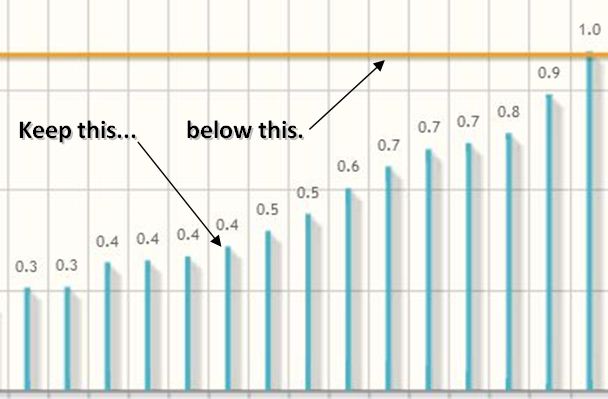Read this if you do timesheets: Seven strategies to get the blue bar under the orange line
“Have you done your timesheets?” This question is loathed by managers and staff alike in a professional services firm. I don’t propose to have the answers, but these strategies and lessons learned may help you if you are responsible for tracking your life in 15-minute intervals.

I walk across the studio floor to see my Lead Graphic Designer and a Project Manager smiling as they look at the monitor. They point to a graph with a series of blue vertical bars and a solid orange line. When I asked what the go was, the project manager said “We did it!”. For the date range they were looking at, all the blue bars were under the orange line except one that was only 0.3 over. There was no reward or incentive for staying under the orange line, just the challenge of doing it. Pondering the scenario after the fact, I realised that the word “timesheet” did not come up in the conversation.
Timesheets: a necessary suckage?

Timesheets have been described as the bane of professional services companies. In a 2010 study of law firms, timesheeting was described as “the worst part of law firm life”. The study calculated overhead for doing timesheets as 3.1 hours per month, or $16,294 per lawyer per year. Similar challenges are felt in digital agencies, albeit at a lower hourly rate.
The criticisms against keeping timesheets are many. Those who protest say forcing timesheet completion does not treat staff as adults. Some take a position that teams should be judged by what they get done rather than how long it took. A few state that time taken to complete timesheets could be better spent working on billable work. There are others who support the concept of tracking time but recommend against charging by the hour and moving towards a value-based proposition.
The move to a values-based accounting approach is appealing, but it is a difficult journey in a traditional fee-for-service industry. “Time” in the form of staff investment remains the common denominator of cost, and costs are measured to predict profit. Some projects are billed at time and materials while others are fixed price based on an initial estimation of time. Timesheets justify billing and determine efficiency in either scenerio.
Timesheets tell you how long something takes, which can be used to assess how much time you have remaining based on the estimate complete (acknowledging planning fallacy and estimating biases). Timesheets can also assist in bottom-up estimating by looking at how time spent on similar tasks, report on costs of business impacts such as quality and scope planning, and are an input to training and personal development as we chat about getting more of what works and less of what doesn’t in our business.
Seven strategies to complete studio timesheets

Timesheets have been a consistent challenge in our digital studio through our growth to over 55 staff. We did not go so far as some like Razorfish who publicly shamed repeat offenders, but we did use emails, pleading, and stern looks to no avail. Some team members consistently lagged behind, while others consistently completed their timesheets. Telling someone to “just be more like so and so” was as ineffective as it sounds.
This has changed over the past several weeks, thanks in part to a blue bar and orange line. I am cautious of providing a to-do instruction list such as “how to get employees to fill out timesheets“. The mentality behind “getting” people to do anything was part of the challenge we had to overcome. That said, feel free to ponder some learning points below and consider how they may help in your own journey:
1. Seek first to understand, than be understood
Such is as the late Covey said. To fully understand timesheeting challenges, we had meetings with each person to understand their perspective. Issues came up such as an incredibly frustrating interface, getting asked to do 20 different tasks in an hour, not knowing the task against which to assign time, being unable to create tasks for new work, and not having time to finish the work before the end of the day, much less record time for the the work. I also started doing timesheets to discover the truth for myself. I discovered that yes, timesheets suck.
We systematically removed each of the barriers, and lo and behold, timesheets became less of an issue.
2. Know why you measure
No one specifically wanted timesheets completed. A timesheet as an end goal of your vision statement is not compelling. Timesheet data does not make you profitable, but it may point to areas where you can increase profitability. Make sure everyone understands why the timesheet data is important and where it sits in the profitability journey; the reason for the pain.
3. Find your lead measure
“Timesheet better” is a lag goal, and a frustrating one at that. Lag goals are things like “improve profitability” or “work harder”. These are difficult to measure and frustrating to achieve. Lead goals are discrete measurable targets that contribute to lag goals.
For the studio, we have a lead goal of reducing the gap between the time effort is applied and the time effort is recorded. If that number is less than 24 hours, I promise to never have awkward timesheet conversations with you again.
4. Do not judge the data
Fear of retribution is a huge barrier to completing timesheets. Gaining visibility into an issue does not mean the issue has not been in place for months. Reactions from managers when exposed to the data can often come from a shame base. Our autocratically-inclined organisations tend to push responsibility and accountability down the hierarchy when everyone in the chain has contributed to the issue at hand.
Timesheet data is a great opportunity to look the information as a group and collectively decide what it means and what actions need to be taken.
5. Make it a game
I am not a big fan of the word “gamification”, but I accept the principles of making work more fun. People spend hours with an Xbox controller staring at their TV, but typing on a keyboard for 10 minutes to enter timesheet data can be like climbing a mountain. While my studio timesheet system will never compete with Halo on the fun-scale, I was adamant I did not want a text-based timesheet report. At some point we may replace the blue bars with Pokémon and the orange line with fire, but for now the graph means we can discuss the topic without using the dreaded word “timesheet”.
6. Get your frame right
I start with a presumption that people are not malicious, incompetent or lazy. On the contrary, I assume they are accountable, highly skilled and diligent. Start from a position that people want to do good and position yourself to help them do good the best they can.
7. Pursue autonomy, mastery, and purpose
Timesheets are a small (albeit important) piece of the studio management puzzle. With accurate timesheet data, we can now better estimate time to completion, which will help with scheduling and identifying ways to improve project efficiency and thereby overall studio efficiency.
I believe once companies achieve a level of profitability to be sustainable, returns from efficiency can be distributed across three areas: 1) to those who make the company a success, 2) invested in personal and corporate growth opportunities, and 3) shared for social goodwill that leaves a legacy beyond the products we produce or services we provide.
People resonate with at least one of these three visions and can determine for themselves the best way to achieve the outcomes.
It’s a journey
Completing timesheets takes involvement from the entire team. It is a journey not a destination, and only one small but important piece towards an end objective of making life better. I would not say we have it perfect, but we are better than we were and improving daily.
I welcome your thoughts on whether the negative stigma can ever truly be removed from timesheeting, or if you feel timesheeting should be completed in the first place.
Please remember to timesheet your response.

Could you not be transparent and share how the time they log impacts the company performance? would this get the buy in required of the team to ensure that timesheets are completed and up to date? could this be incentivised in some way?
I dont have the answer but it is a very interesting issue and not one that is the sole domain of professional services companies. We need timesheets internally to capitalise labour on large projects and so face an even higher mountain when you consider that for most commercial enterprises timesheets are not really used that much.
Perhaps a better way to approach this dilema is to have the project management approach support timesheets. i.e. when you finish a task and mark it complete the time is automatically accounted for that way not time sheet necessary, only variances to the planned time needs to be noted.
Good thoughts Barry. You raise the need for the next steps of transparency and attributing the results to incentives. Accuracy and completeness are essential, as things take on a whole new meaning when you touch the wallet. 🙂
Our next step is team and individual reward after achieving X% efficiency. For this to work, we need to itemize all that could impact the results.
We played with totaling time when tasks are complete. The challenge here is that we support a degree of client flexibility that has us working on many things a day or even an hour. We try to minimize this to few interruptions, but we still see jumping around. If not accounted for, it can skew results and make for improper assumptions on efficiency. Your comment on variance reporting is very relevant, though.
Great article. I’m beginning to explore new ways of getting time sheets in as they are a real pain in the a**. What software do you use?
A
Hi Adele,
Yes, timesheets can be painful. I heard timesheet software being referred to as “lipstick on a pig” :).
We used a custom solution in our studio, but we used Timesnapper (http://timesnapper.com/) to help keep track of when we did what. I highly recommend it, as it allows you to go back and add time stamps to screenshots for when you can’t recall when you did what. At the moment in my consultancy role, a simple Excel spreadsheet does the trick, but I know there are other tools available depending on how integrated you need them to be with other systems.
Hope that helps!
Chad
Hi Adele,
I have had a really tough time getting folks in the studio to do timesheets, so I sat the guys and girls down and asked why the timesheets were such a bother, most of the reasons could not be avoided, but, ease of use kept coming up, so I asked everyone to look for a software they were comfortable with and went through a few.
Short story, we eventually built our own using the accumulated wisdom from. You can check it out and see if it is any use to you and your team? http://vezbo.com/
Thanks for the tip, Job!
Oh Chad, I enjoyed the first few paragraphs of your article – and yes, timesheets do suck!
But there’s no place for them in professional firms – law, accounting and especially creatives -> they just kill the creativity!
The unfortunate thing about timesheets (and evident by your article above too) is that they have nothing to do with the value that you provide the client. No where above is the lead indicator or key metric of the team measured in “Value we provide to the customer”. In contrast it is the ‘keep the blue line below the orange line’. Would clients be impressed to see that the job came under budget (or timesheets were in on time – I can’t tell what the orange line is), or that the client was delivered the best possible outcome?
Let’s look at Southwest Airlines. Their lead indicator was ‘$ per airline mile’. When the CEO changed this to ‘% of on-time arrivals’, business went through the roof! They measured what was important to the customer.
There is a better way of managing people and timesheets belong in the bin. 🙂
Commented with love too, not an attack 🙂 and there’s plenty more stuff on this here http://www.verasage.com/
Cheers,
-Ben
Hi Ben,
Great comments, and I agree with your sentiment of a move towards value-based tracking. I understand your positions that tracking time sheets impacts creativity and that timesheets are not associated with the value of the outcome.
In the agency, we operated under fixed price or time and materials contracts, and variations of each such as retainer models. Using work we did for one company as an example, we were doing about 3,000 hours of work made up of a few large 6-month fixed-price projects, a dozen smaller time and materials requests ranging from an hour to a day, and two to three regular promotional activity between 20-30 days worth of work to be completed in one to two week turn-around. This was done across six technology disciplines and 60 staff over two sites.
For all of this, time was the common denominator of cost. Before a project started, we defined the scope and estimated how much time it would take to complete the scope. As we did the work, we kept track of the time to see how close we were to realising our target. When we completed the job, we reflected on how close we were to the estimate. Variations between the length of actual time taken and the estimate could mean a range of things, such as we added or removed scope, the person doing the work was more or less experienced than expected, or there were other unforeseen impacts.
The greater the complexity of the situation, the more we look for simplicity in management. Research into ambidexterity highlights the need for both autonomy as well as strong accountability and financial controls at the individual level. I also believe there needs to be a connection of each individual to the purpose of vision of the organisation and a clear line of site as a team member from what I do to the real value I provide. These principles are foundational to methodologies such as agile, which hold promise as frameworks to embed measurable value in what we do. I look forward to seeing large-scale examples of these principles in practice.
Good points, II look forward to hearing of your success!